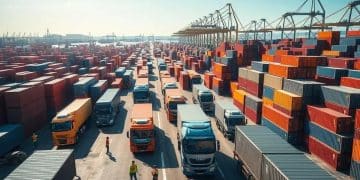Supply chain recovery: strategies for business resilience

Supply chain recovery involves strategies that restore business operations after disruptions, focusing on diversification of suppliers, risk assessment, technology integration, and sustainability to enhance resilience and efficiency.
Supply chain recovery is more important than ever as businesses navigate disruptions. Have you considered how your operations can bounce back stronger? Let’s dive into effective strategies and insights.
Understanding supply chain recovery
Understanding supply chain recovery is essential for businesses aiming to thrive after disruptions. A well-prepared supply chain can adapt to changes and maintain efficiency.
What is supply chain recovery?
Supply chain recovery refers to the strategies and processes used to restore operations after a disruption. This can involve logistical adjustments, supplier negotiations, and process improvements.
The importance of quick recovery
A quick recovery ensures that companies minimize losses and maintain customer satisfaction. A responsive supply chain can reestablish operations faster, leading to a competitive edge.
- Reduce downtime
- Restore customer confidence
- Reinforce supplier relationships
When companies face unexpected challenges, a robust recovery plan helps them bounce back stronger. This dynamic approach to supply chain recovery mitigates risks and prepares businesses for future disturbances.
Key components of effective recovery
Several factors contribute to a successful recovery. Companies should consider the following:
- Assessing vulnerability of the supply chain
- Implementing redundancy in key areas
- Utilizing technology for real-time tracking
By understanding and developing these components, companies can achieve a smoother recovery process. Establishing a culture of continuous improvement is vital, as it empowers teams to learn from experiences and innovate solutions.
Ultimately, supply chain recovery is about resilience and preparation. Companies that invest in creating flexible and responsive supply chains will not only recover but flourish amidst challenges.
Key challenges in recovery efforts

When examining key challenges in recovery efforts, it’s crucial to understand the hurdles that businesses face during disruptions. Every organization must be prepared to tackle these issues to effectively restore operations.
Identifying supply chain vulnerabilities
One significant challenge is identifying specific vulnerabilities within the supply chain. Companies often struggle to pinpoint weak points, which may lead to delays in recovery. Creating a comprehensive risk assessment can help highlight these vulnerabilities.
Supplier dependency
Another challenge involves dependence on a limited number of suppliers. This dependency can create bottlenecks when a supplier is unable to deliver on time. Establishing multi-supplier strategies can lessen risks and improve resilience.
- Diversifying suppliers
- Building strong relationships
- Negotiating flexible contracts
Additionally, communication breakdowns can severely impact recovery efforts. Ensuring clear communication across all parts of the supply chain is essential for smooth operations. Regular updates, transparent dialogue, and collaborative problem-solving can help mitigate these issues.
Technology integration
Many organizations face challenges with technology integration. Implementing new systems requires time and training, which can slow down recovery. Organizations must ensure their teams are trained to use technology effectively. Investing in user-friendly solutions can also facilitate smoother transitions.
Lastly, external factors, such as economic shifts or natural disasters, often disrupt recovery efforts. Businesses must be ready to adapt quickly to these unforeseen changes. Having a robust recovery plan that accommodates various scenarios is vital for success.
Strategies for enhancing supply chain resilience
To enhance supply chain resilience, businesses must adopt specific strategies that foster flexibility and adaptability. These strategies help organizations deal with disruptions more effectively and maintain continuity.
Diversification of suppliers
One critical strategy is the diversification of suppliers. By engaging multiple suppliers for key materials, companies can reduce dependency on a single source. This approach minimizes risks and ensures that operations continue smoothly, even if one supplier encounters issues.
Risk assessment and management
Conducting regular risk assessments can also strengthen resilience. Identifying vulnerabilities within the supply chain helps businesses prepare for potential disruptions. Companies should create contingency plans that address various scenarios, allowing them to respond swiftly to challenges.
- Regularly review supplier performance
- Establish clear communication channels
- Train employees on crisis management
Another strategy is to invest in technology that enhances visibility across the supply chain. Tools like real-time tracking and data analytics allow companies to monitor shipments and identify issues before they escalate. This proactive approach enables quicker response times and empowers teams to make informed decisions.
Building strong relationships
Building strong relationships with suppliers and logistics partners is vital. Collaborative partnerships foster open communication, leading to improved problem-solving during crises. Businesses can work together to find creative solutions that maintain the flow of goods and services.
Training employees to adapt to new technologies and processes is equally important. As supply chains evolve, ensuring that teams are well-prepared can minimize disruptions. This investment in human capital nurtures a culture of resilience, where employees are equipped to handle unexpected challenges.
In summary, enhancing supply chain resilience requires a multifaceted approach that includes risk assessment, supplier diversification, and technology investment. By implementing these strategies, businesses can better withstand disruptions and maintain operational efficiency.
Future trends in supply chain management

Future trends in supply chain management are shaping how businesses operate and respond to challenges. Companies must stay ahead of these trends to maintain a competitive advantage.
Automation and AI Integration
One significant trend is the increased use of automation and artificial intelligence (AI). By automating routine tasks, businesses can streamline operations. AI can help analyze data to predict demand, optimize inventory, and improve decision-making.
Sustainability Practices
Another important trend is a focus on sustainability. More companies are aiming to implement green practices throughout their supply chains. This includes using eco-friendly materials, reducing waste, and lowering carbon footprints. Customers increasingly prefer to support brands that prioritize sustainability.
- Developing circular supply chains
- Reducing packaging waste
- Utilizing renewable energy sources
Additionally, the growth of e-commerce is transforming supply chains. Businesses must adapt to faster delivery expectations. This requires rethinking logistics and distribution methods. Companies that can fulfill orders quickly and efficiently will win customer loyalty.
Supply Chain Visibility
Enhanced visibility is another trend. Technologies like blockchain and IoT (Internet of Things) are providing better tracking of products in real-time. This transparency helps in identifying bottlenecks and improves overall efficiency. Businesses that embrace these technologies can respond faster to changes in demand.
Collaboration is becoming increasingly valuable as well. Companies are teaming up with suppliers, logistics providers, and even competitors to share resources and information. This collaborative approach fosters innovation and resilience in the supply chain.
By focusing on these future trends, businesses can develop more robust and responsive supply chain management practices. Staying ahead means being flexible and ready to adapt to changing market conditions.
FAQ – Frequently Asked Questions about Supply Chain Recovery
What does supply chain recovery mean?
Supply chain recovery refers to the strategies and processes that businesses use to restore operations after disruptions.
Why is risk assessment important for supply chain resilience?
Regular risk assessments help identify vulnerabilities in the supply chain, allowing companies to prepare effective contingency plans.
How can technology enhance supply chain operations?
Technologies like automation and AI improve efficiency by streamlining processes and providing real-time data for better decision-making.
What role does sustainability play in supply chain management?
Sustainability practices are becoming essential as customers prefer brands that prioritize eco-friendly operations and reduce their carbon footprints.






